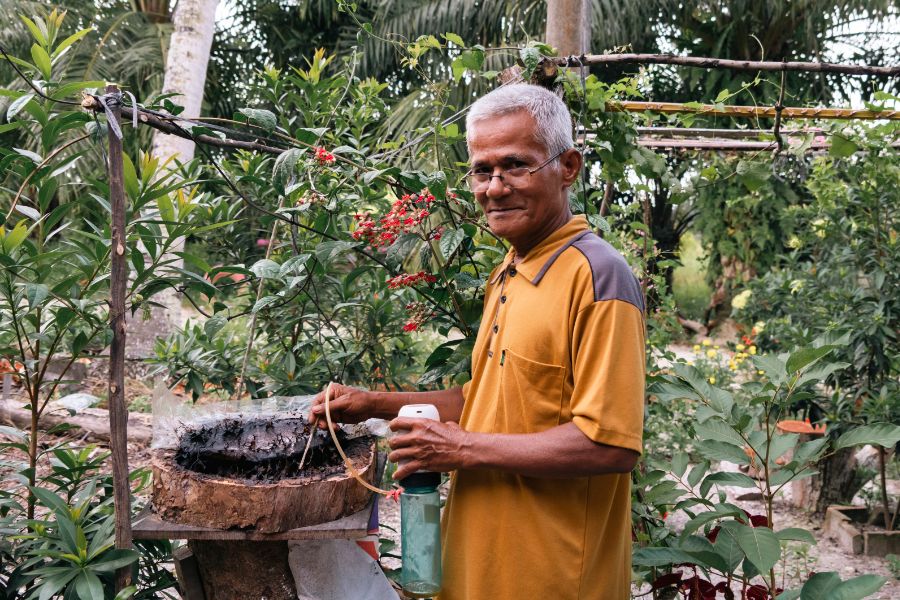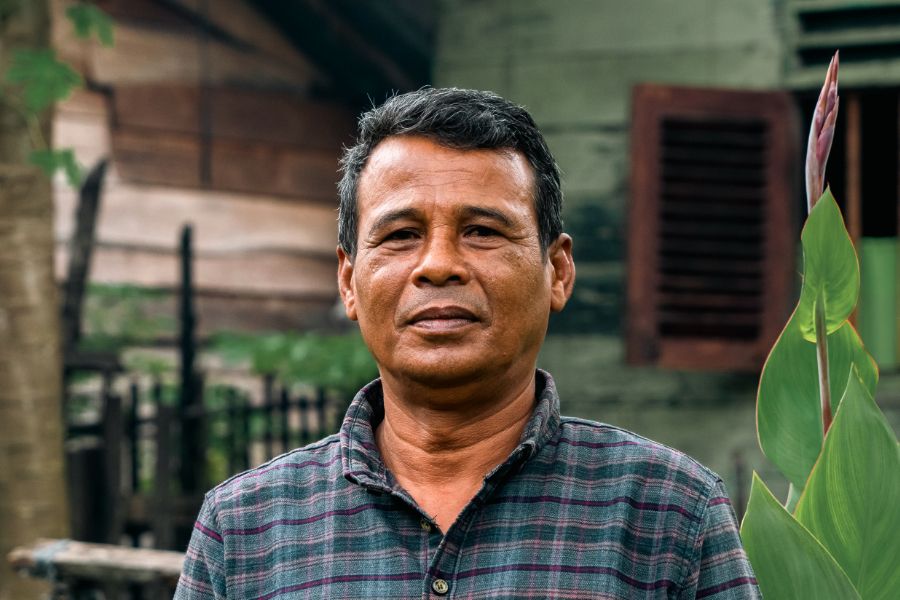A village against oil palms
In the small green village of Pasar Rawa, under the canopy of a wooden pavilion recently built on the riverbank to host community activities, the villagers are rejoicing. Three years of struggle against illegal oil palm plantations on their land is finally coming to an end. In 2019, the palm oil company PT Sumber Hasil Prima broke into Pasar Rawa without official permission. In order to install oil palm trees, the company deforests 138 hectares of mangroves on village land overnight. Supported by our partner Yagasu, the community mobilised and warned the government. The government then called in the Indonesian forestry police to note the illegal occupation of the plots by the company and the deforestation of the mangroves that were originally located there. PT SHP was then forced to leave the site, leaving behind severely degraded land, which was returned to the villagers. Today, thanks to the support provided by Yagasu and the financing of Reforest'Action, the mangrove has regained its rights around Pasar Rawa. In this village of barely a thousand people, more than 300 are involved in the mangrove restoration project - a number that has been growing every year since 2019. Awarded the National Environment Award, the community was visited in 2021 by Eko Sri Haryanto and Dr. Sumarlan, both from the Ministry of Villages, Disadvantaged Area Development and Transmigration of the Republic of Indonesia, who came to personally congratulate the villagers for their struggle to restore the mangroves.

Mangroves in colour
The inhabitants of Pasar Rawa are now turning to the preservation of the mangroves that surround the village, and are integrating their natural resources into their daily lives. Accompanied by Yagasu, which provides materials and training, women's groups are learning how to produce batik, an ink made from mangrove branches to dye traditional local fabrics. Under the wooden pavilion by the river, we meet Hamidah, a batik trainer in the Pasar Gebang region. Leaning over a pewter vat in which the dark ink is simmering, she takes the time to explain her creative process. "We collect dead mangrove branches from the mangrove swamp and stew them in boiling water until a coloured liquid emerges. This ink, blue or brown depending on the type of tree, is then used to colour the patterns that we have first drawn and fixed with wax on fabrics. Then the colour has to be locked in with a fixing mechanism so that the batik dye does not fade over time." In Pasar Rawa and several surrounding villages, a real economic sector is now developing around batik, as Hamidah still testifies, proud that the fabrics are sold to passing customers.


Bees for the mangrove
Some 40 kilometers further north, the village of Lubuk Kertang also has a story of resilience in the heart of the mangrove. We are greeted by Zul, the village chief, and Ali, a beekeeper, who take us to a small, lush and cleverly landscaped garden. "When we were younger, the village was surrounded by mangroves and teeming with bees," they say. "But since 2006, almost all the forests have been converted to oil palm crops, and the bees have disappeared completely." Deeply disoriented by the loss of his childhood landscape, Zul decided to join the mangrove restoration project led by Yagasu in 2017. At the same time, he is thinking of a way to bring back the lost bees so that his community can benefit from their honey again. Using a dead mangrove stump, he creates the conditions for a beehive to establish itself, and plants a garden rich in plant biodiversity at the doorstep of his house. Ali, the beekeeper, then takes charge of collecting a queen from the nearby mangrove. The rest of the colony soon followed. Thus was born the first hive in Lubuk Kertang for more than fifteen years. For the time being, the honey produced comes from the flowers in Zul's garden, but the ambition is to transplant this floral treasure to the regenerated mangrove near the village. Because mangrove trees only bloom once or twice a year, depending on their species, the garden's flowers will allow the bees to remain sedentary and not go further afield to look for nectar, while pollinating the Avicennia and Rhizophora flowers when they appear, in February, June and October. "The mangrove is a source of life," says Zul, "but also of economic income for our communities." Today, the honey collected by Ali is sold in the small shops of Lubuk Kertang. Tomorrow, the village hopes that the bees can find a sustainable home in the heart of the mangrove.


The ocean has roots
The province of Aceh in northern Sumatra was hit hard by the 2004 tsunami. Here in Rantopanjang, villagers speak of the tsunami as an event that radically cut the timeline of their lives in two. "There was a before and after," says Mukhtar, a villager in his fifties who is involved in the reforestation project with Yagasu. "When I was younger, the mangrove forests around Rantopanjang were very dense and lush. But the tsunami devastated everything. The climate changed after the trees disappeared. The mangroves had a key role in cooling temperatures and preventing the beaches from eroding. Today, coastal abrasion is massive, and that's why I started planting mangroves." Since the tsunami, the local climate has indeed changed. The washed-out coastal mangroves were valuable for sequestering atmospheric carbon and maintaining the region's soils. Although their natural barrier acted as a protection for coastal villages, their destruction led to increased flooding events due to coastal erosion and increased rainfall. North Sumatra is now even more vulnerable to climatic hazards, especially during the wet season, which runs from October to April.
But, continues Mukhtar, another plague is responsible for the destruction of the mangroves that survived the tsunami: the proliferation, over the last ten years, of intensive aquaculture ponds. These artificial ponds, which replace natural mangrove forests, are a source of immediate income for the communities, but they are not sustainable. When their productivity decreases, they are abandoned as they are, and their antibiotic-laced water contaminates the entire surrounding ecosystem. "The mangroves, on the other hand, are a natural refuge for many species of crabs, molluscs, crustaceans and fish," explains Mukhtar. Thanks to the project financed by Reforest'Action, the villagers of Rantopanjang have become aware of the harmful impact of intensive ponds and are now committed to the reintroduction of the mangrove and the creation of organic silvo-fishery ponds that enhance the natural biodiversity of the mangrove. Convinced that such sustainable fishing practices will be more beneficial in the long term for the village's food security and local economy, Mukhtar is pleased: "Fish production has increased by 30% in three years thanks to the restoration of the mangrove. We have a lot to gain by protecting our forests. Putting roots back into the ocean - that is Mukhtar's plan to feed the community, and return the village to its former landscape.

The sweet sap of palm trees
Naturally present in the mangrove, in association with the different species of mangrove trees, the nipa palm holds a little-known resource that the inhabitants of the village of Abeuk Geulanteu have discovered thanks to the project led by our partner Yakopi. Traditionally, this palm tree, which is the only one of its kind that can grow in water, was used to create vegetable fibre roofs. But this practice required the complete cutting of the tree, thus contributing to deforestation in mangrove ecosystems. With the objective to conserve the integrity of the forests, Yakopi is thinking of a solution for local communities to continue to integrate nipa into their economy without cutting down the palm trees, which are valuable for maintaining the muddy soils that they help to fix with their roots. This is how the production of palm sugar, made from the sap of the nipa tree, is spreading in the villages associated with the project.
Each nipa stem is particularly prolific and can secrete up to one litre of sap per day. Where only the mangrove monkeys used to enjoy this precious nectar at dawn, before the villagers woke up, it is now the whole village of Abeuk Geulanteu that mobilises in its harvest. The process is simple and renewable: first, the fruit-bearing stem is shaken to condense the sap at its tip, then the fruit is harvested and the sap is collected from the branch using a small bag. The sap, which has a milky, coconut-like texture, can be consumed directly as an energy drink. It can also be cooked to extract a natural sugar, rich in minerals and with a particularly low glycaemic index, which is used for cooking or sold in local markets. The fruit is also consumed by the villagers and contributes to their food security. The product can be stored at room temperature for up to a year, and is now attracting consumers not only locally, but also increasingly abroad. Because the production of nipa sugar does not involve cutting the plant that produces it, it is a sustainable alternative to cane sugar production. Today, thanks to this economic sector, the villagers benefit from an additional income and the value of these trees has been multiplied - thus offering them the guarantee of their protection and that of the mangroves which shelter them.



